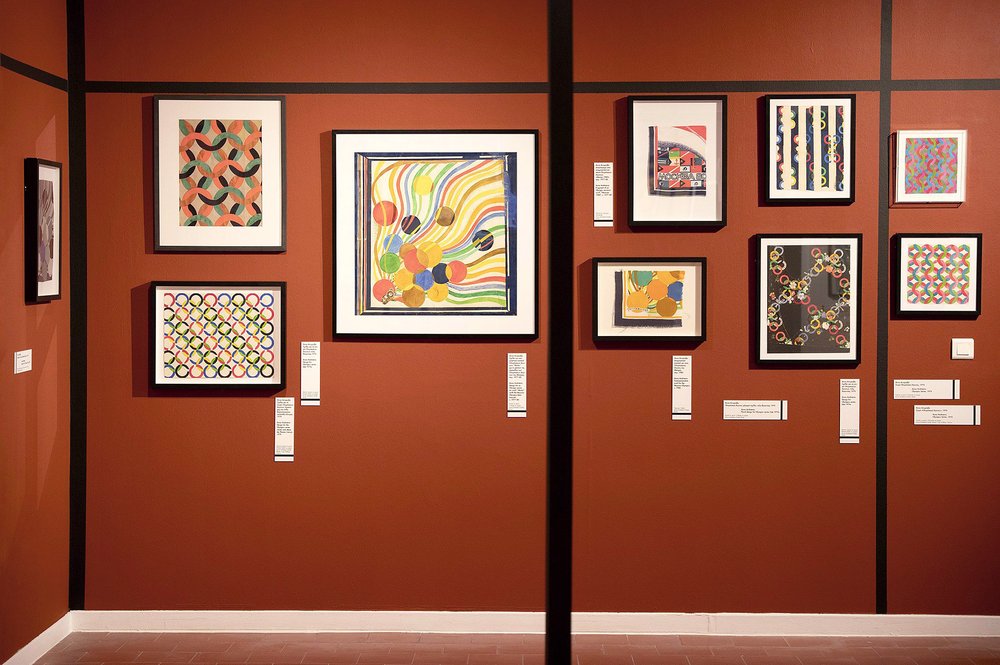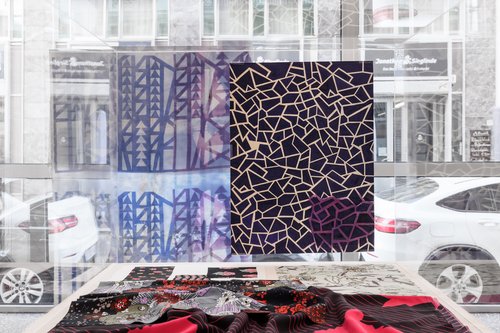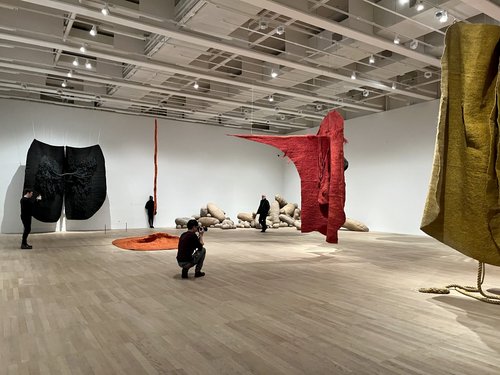Christina Kiaer: Pulling the Thread

Collective Threads: Anna Andreeva at the Red Rose Silk Factory. Exhibition view. Thessaloniki, 2025. Courtesy of MoMUS – Museum of Modern Art – Costakis Collection
An exhibition of Soviet textile designer Anna Andreeva is now on view at MoMUS Museum of Modern Art in Thessaloniki. Its curator Christina Kiaer talked to Art Focus Now about women in art in the Soviet Union and the surprising circumstances in which they found themselves.
Despite her revolutionary and iconic designs, the legendary soviet textile designer Anna Andreeva (1917–2008) has largely fallen into obscurity. Christina Kiaer, an art historian specialising in Soviet art history and Professor of Art History at NU is one of a small group of dedicated scholars and curators who have been working at shining a spotlight on Andreeva. Kiaer has recently curated ‘Collective Threads: Anna Andreeva at the Red Rose Factory’ at MOMus in Thessaloniki and will soon present a book about her work. Art Focus Now caught up with her to find out more about Anna Andreeva, the challenges faced by women artists in the Soviet Union as well as the surprising advantages the patriarchal and totalitarian soviet system offered them.
Michael Voeikov: What was it that drew you to Andreeva's work in the first place? How did you discover her and what made you such an admirer?
Christina Kiaer: In May 2023, I was sitting on my terrace when the phone rang. It was a friend, Anton, who asked me if I would write a catalogue essay for the Shanghai Biennale, which he had just agreed to curate, about Soviet textile designer, Anna Andreeva. I was curious: Anton is interested in Russian Cosmism and he wanted to include Anna Andreeva in the theme of the bienniale, which was Cosmos Cinema. So I decided to go to Vienna and visit the gallery that is managing Andreeva`s estate to see her works in person.
I understood immediately that she was part of the legacy of the Russian avant-garde, which I had written so much about. And I saw that when people talked about her in relation to the avant-garde, it was always because of a visual connection. They would say it looks like Popova or it looks like Stepanova. I saw Andreeva as a continuation of the legacy of the avant-garde. Visually and not only artistically but structurally, I saw her as fulfilling the dream of the constructivist avant-garde which was completely unexpected in the grey Soviet 1950s and 1960s.
MV: Would you say that Andreeva and the people who worked with her were sidelined as artists due to the nature of the Soviet artistic industry and that in the West, she could have perhaps become a more prominent artist. Or alternatively the Soviet system helped her in the sense that she didn't get to choose what she was working on, she was given tasks and therefore her portfolio over the years became ever more encompassing?
CK: Yes, I think artists often work well when they are given limits or constraints, when they cannot just do whatever they want. That can then make certain forms of creativity possible that might not have been happened if they had not been given a task. This goes back to the Renaissance, where artists were given commissions, where they had patrons who told them that what they were to make had to have this or that, you could not just do what you wanted. There are a few Western fabric designers who are operating at the very top end and can do whatever they want but I think most fabric designers working for fashion houses are given tasks. In the capitalist model, the restraints are not ideological, they're financial, they just want to make money and I then as a scholar would say, well, that's ideological too. It's just capitalist ideology.
MV: There is the perception among some in the West that the Soviet Union provided equal opportunities, while the Western work culture resembled an episode of Mad Men. Of course, we know that in reality, it was moulded by the pure rationale of the dictatorship, where every single person needed to be involved in order to advance the cause and the economy. In your opinion, how would the soviet art scene correspond with their counterparts in the West?
CK: At least the early Soviet government actually did believe in it and they were actively interested in women's emancipation and did not just give it lip service. Of course, everything failed to materialise to the extent of all the promises, but still, by 1918, the Soviet Union was a place where women had equal rights, at least on paper. The right to divorce, the right to abortion, and the right to vote that women in lots of other countries did not have.
When we get into the post-war era, things become more sexist. There is more of an emphasis on male artists - some of the paintings of the Austere Style are almost ridiculous where men are twice as big as women, huge, brawny men. We get into the whole double burden and the whole problem of Soviet femininity. But the Red Rose, I think it is a great question about Andreeva because society around her is so double and then she enters into this collective, and there are only women. There were never any male artists at the Red Rose Factory. There were some male fabric designers, but very few. So you are in a totally feminised field, and within this feminised field there is a space for this incredible flowering of creativity and this vast artistic output.
I have not done a study of female textile designers from the 1950s to the 1970s in Western Europe or the United States. I have taught a class called ´Women in Textiles´ during the modern era where we have examples like Sonia Delaunay (1885–1979) and Anni Albers (1899–1994), but they are different, they are more in the high art space. I don't know about this particular industrial production space amongst women in the West but I do think that in the Soviet Union it is part of the story of female artists. And this goes back to constructivism, where the constructivists said that art is bourgeois, and we are now going to make new things. That era was feminist on multiple levels, not just that it had Lyubov Popova and Varvara Stepanova and other female artists who were very prominent, but that the male artists were themselves participating in feminised material culture. It was a kind of critique of the masculinity of high art.
Then everything shifts once we get into the 1930s. Suddenly, there are very few major female artists. It is very hard to become a major painter if you are a woman because you need access to studio space, you need access to paint. They are very hard to get, and the hierarchy of the artist union is predominantly male. You lose a lot of that egalitarianism of the 1920s. And then, in the post-war era, it all shifts again, that rhetoric of egalitarianism. It is still there, but there has also been a return to femininity, a celebration of femininity and maternity. So there is this kind of schizophrenic culture where you have both art showing us images of female workers who are powerful and at the same time cosmetics and fashion. And so I think that these female designers are a strong kind of counter-narrative. I think that they form a part of the narrative of Soviet art in the post-war era that is partially a counter-narrative to our received ideas. They are extremely celebrated and prolific and written about and so they are very much a part of the Soviet art world even though they are not at the highest echelons.
MV: How would you say, in your personal opinion, women artists were perceived in the Soviet Union? How were they treated in comparison with their Western counterparts in terms of recognition?
CK: I would actually say they were more recognized. I have studied feminist art in the West, in Europe and America, in the post-war era and female artists were few and far between, they were exceptions. And there were the most blatant examples of sexism constantly in the way that women artists were written about. And that is why in the 1960s you had a woman's movement and in the early 1970s you had the feminist art movement that really protested against the masculine art world, there was the rise of the Guerrilla Girls later on in the 80s, women artists then have the freedom not to worry about high-level commissions and all the stress that comes along with that. They don't have to worry about getting work ready for the Whitney Biennial because they're not even invited.
And so, I would say in the Soviet Union, because of its nominal communist feminist egalitarianism, because they were held to that rhetoric, I do think that the actual effects were more feminist. Even though we can look at Soviet feminism and say, “Oh, but it's a double work burden, and it's not fair, and Russian men just want to get drunk and beat up their wives.” officially, that was not the feeling. It was important to have women artists and to celebrate the achievements of women. I can talk about the United States, but the way that women artists were written about there was like, oh “this little lady can paint”, that kind of thing. Eva Hesse (1936–1970) was an active part of the minimalist movement, but the criticism written about her often tended to be about her biography and how attractive she was. You see this again and again. The female abstract expressionist Lee Krasner (1908–1984) married Jackson Pollock (1912–1956). There is art criticism that says “Jackson Pollock's talented wife is also an abstract painter. And she tidies up, her little abstract squares tend to tidy up and organise his molten lava outpouring of creativity.” So, I would come down hard in favour of the fact that there was a different seriousness accorded to women artists in the Soviet Union, even if we acknowledge that the effects might not have been all that different. It is an interesting question. It would be interesting to do a deep dive into say US textile design companies in the 1950s and 1960s and see how many female designers there were and how much they were recognised.
MV: How do you think Soviet women artists were able to be perceived in such a progressive manner while simultaneously existing in such a patriarchal society?
CK: Well, it's about how ideology works, right? That the ideology was firmly egalitarian and pro-women's emancipation. That was the official rhetoric the whole way through. That is an interesting study of ideology reception that probably a lot of people just kind of rolled their eyes whenever they heard it. Sort of like Soviet anti-racism, which I have written about, that in the 1930s, to a great extent seemed quite genuine, partly because it was easy to be outraged at US racism when there were only six black people in Moscow.
I imagine that there must have been a kind of double experience of femininity in the Soviet Union, both the kind of equality in education, the emphasis on women entering into science and administration and women becoming leaders in the workplace, that there is rhetoric about that, even though a lot of women also experience that glass ceiling. You do not have that many high-level female party members and when you see the Politburo it is basically just all these grey men.
MV: Ironically enough the only one was the Minister of Culture.
CK: Right, who was a terror and everyone was afraid of her. Yes, exactly. And that is as Russians would say “не случайно” (“not by accident”), that it was just the Ministry of Culture which is a kind of lower-level thing.
Right, so no one is claiming some kind of feminist utopia. That is completely untrue. I think a perfect example is International Women's Day, which started out as a socialist holiday. There is that grand history, and of course, it has devolved into a holiday where men give flowers to women and get really drunk, right?
By the time I arrived in the ex-Soviet Union in the 1990s, as a young feminist coming from the United States, it was almost comical how sexist everything was. Much more so than the U.S. Maybe not actually, but in the US, the rhetoric had been changed. Men did not go around saying the kind of crap that they would say to me when I arrived in the Soviet Union.
I think Anna Andreeva was in many ways a very traditional person. She was married to a mathematician. They were very much in love. She had her kids. She did her thing. She was both super professional and an attractive woman and a wife and mother. It seems that the Soviet system really worked well for a woman like her and her colleagues. It may not have worked as well for a lot of other people.
MV: I suppose although we cannot call her a feminist icon, I think in some ways she was one.
Feminist icon…that's interesting. You know, yes and no.
MV: So, as a scholar, how would you say the perception of Soviet and Russian art has changed since 24th February 2022?
CK:. It has been extremely tough for those of us who have dedicated all our scholarly lives to Russian art and cannot go there now to carry on creating more knowledge and building on our expertise. It is very difficult.
With Anna Andreeva its a special case, as this is a renowned Soviet textile artist, whose works are in the permanent collection of MoMa New York. She is a woman. I think I'm going to steal your idea of a feminist icon; I think it is a nice one. So, here we have a feminist icon. We have unknown Soviet textiles and an exhibition about material culture.
MV: So where do you stand on that awful term “cancel culture” when it comes to Russian art? Frankly, I think that this term has been overused because it is used by so many people to describe not so much cancel culture but the reasonable questioning of Russian soft power through the arts. When it comes to this approach and narrative that anything related to Russia, culturally or artistically, has become toxic for obvious reasons, where do you stand on that?
CK: As a historian, I am very much against that. In these situations, we need more history, more knowledge, more understanding, not less. I am shocked by this cancel culture and the way everybody just immediately said, no, we absolutely cannot support Russian culture, Russian history, or anything like that. I completely disagree with this. It seems to me incredibly short-sighted. During the Cold War, there was a lot of interest back and forth between the two cultures because they felt that they needed to know more. I think that that can be the case today.
I think there should be a space for thoughtful historical research. And I'm speaking as a scholar and a historian. Historians believe passionately that if we ignore history, we're bound to repeat it. And so I find that kind of moralism to be absolutely nonsensical, and that if there are people who are doing serious historical work and wanting to show where things came from and how things worked in the Soviet Union or even in pre-revolutionary Russia that this is not something that should be cancelled but rather embraced.
Collective Threads: Anna Andreeva and the Red Rose Silk Factory
MoMUS – Museum of Modern Art – Costakis Collection
Thessaloniki, Greece
8 December 2024 – 27 April 2025
Collective Threads. Anna Andreeva and the Red Rose Silk Factory
https://www.scheidegger-spiess.ch/en/product/collective-threads/1583
Zurich, Switzerland
Expected release date – March 2025























